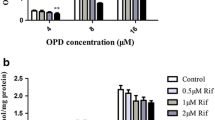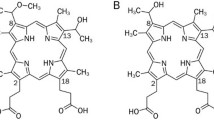Abstract
Purpose
Our previous pharmacokinetic studies have demonstrated that TR-14035, a novel dual antagonist for α4β1/α4β7 integrin, selectively and strongly accumulated in the liver and was mainly excreted in bile as an unchanged drug. In the present study, we investigated the hepatobiliary transport system in detail.
Materials and Methods
Uptake by hepatocytes and organic anion transporting polypeptide (OATP)-expressing Xenopus laevis oocytes or Flp-In-293 cells was performed in vitro. Biliary excretion was investigated in mdr1a/b-knockout mice, Bcrp-knockout mice and Mrp2-defective Eisai hyperbilirubinemic rats (EHBRs).
Results
TR-14035 was taken up by rat and human hepatocytes by an apparently single saturable mechanism with K m of 6.7 and 2.1 μM, respectively, and taurocholate and digoxin reduced this uptake. OATP1B1/OATP-C and OATP1B3/OATP8 expressed in oocytes mediated the TR-14035 uptake with K m of 7.5 and 5.3 μM, respectively. OATP1B1*15, a genetic variant of OATP1B1, exhibited a decreased transport of TR-14035 compared with OATP1B1*1a. Biliary excretion and total body clearance of unchanged TR-14035 in EHBRs were significantly lower than those in normal rats, while there was no difference in the clearances between wild and mdr1a/b- or Bcrp-knockout mice.
Conclusion
These results indicate that OATP1B1 and OATP1B3 are at least partly responsible for the accumulation of TR-14035 into hepatocytes, and Mrp2 principally mediates the biliary excretion of TR-14035. Furthermore, genetic polymorphisms of OATP1B1 may cause an interindividual variability in the pharmacokinetics of TR-14035.









Similar content being viewed by others
Abbreviations
- AUC:
-
area under the plasma concentration-time curve
- BCRP:
-
breast cancer resistance protein
- CL b :
-
biliary excretion clearance
- CL r :
-
urinary excretion clearance
- CL tot :
-
total body clearance
- CYP:
-
cytochrome P450
- EHBR:
-
Eisai hyperbilirubinemic rat
- FCCP:
-
carbonyl cyanide-p-(trifluoromethoxy)-phenylhydrazone
- K m :
-
Michaelis-Menten constant
- k ns :
-
nonsaturable uptake clearance
- KO:
-
knockout
- LC-MSD:
-
liquid chromatography-mass spectrometric detection
- LC-MS/MS:
-
liquid chromatography-tandem mass spectrometry
- MDR:
-
multidrug resistance protein
- MRP:
-
multidrug resistance-associated protein
- MRT:
-
mean residence time
- NTCP:
-
sodium/taurocholate cotransporting polypeptide
- OAT:
-
organic anion transporter
- OATP:
-
organic anion transporting polypeptide
- OCT:
-
organic cation transporter
- PAH:
-
p-aminohippuric acid
- PPB:
-
plasma protein binding
- SNP:
-
single nucleotide polymorphism
- TEA:
-
tetraethylammonium
- Vd :
-
volume of distribution
- V max :
-
maximum uptake rate
References
C. Berlin, E. L. Berg, M. J. Briskin, D. P. Andrew, P. J. Kilshaw, B. Holzmann, I. L. Weissman, A. Hamann, and E. C. Butcher. α4β7 integrin mediates lymphocyte binding to the mucosal vascular addressin MAdCAM-1. Cell74:185–195 (1993).
C. Berlin, R. F. Bargatze, J. J. Campbell, U. H. von Andrian, M. C. Szabo, S. R. Hasslen, R. D. Nelson, E. L. Berg, S. L. Erlandsen, and E. C. Butcher. α4 integrins mediate lymphocyte attachment and rolling under physiologic flow. Cell80:413–422 (1995).
I. Sircar, K. S. Gudmundsson, R. Martin, J. Liang, S. Nomura, H. Jayakumar, B. R. Teegarden, D. M. Nowlin, P. M. Cardarelli, J. R. Mah, S. Connell, R. C. Griffith, and E. Lazarides. Synthesis and SAR of N-benzoyl-l-biphenylalanine derivatives: discovery of TR-14035, a dual α4β7/α4β1 integrin antagonist. Bioorg. Med. Chem.10:2051–2066 (2002).
M. Tsuda-Tsukimoto, Y. Ogasawara, and T. Kume. Pharmacokinetics and metabolism of TR-14035, a novel antagonist of α4β1/α4β7 integrin mediated cell adhesion, in rat and dog. Xenobiotica35:373–389 (2005).
M. Tsuda-Tsukimoto, Y. Ogasawara, and T. Kume. Role of human liver cytochrome P450 2C9 in the metabolism of a novel α4β1/α4β7 dual antagonist, TR-14035. Drug Metab. Pharmacokinet.20:127–134 (2005).
B. Hagenbuch and P. J. Meier. Organic anion transporting polypeptides of the OATP/SLC21 family: phylogenetic classification as OATP/SLCO superfamily, new nomenclature and molecular/functional properties. Pflugers Arch.447:653–665 (2004).
H. Koepsell and H. Endou. The SLC22 drug transporter family. Pflugers Arch.447:666–676 (2004).
P. Chandra and K. L. Brouwer. The complexities of hepatic drug transport: current knowledge and emerging concepts. Pharm. Res.21:719–735 (2004).
B. Sarkadi, C. Özvegy-Laczka, K. Német, and A. Váradi. ABCG2—a transporter for all seasons. FEBS Lett.567:116–120 (2004).
H. Baur, S. Kasperek, and E. Pfaff. Criteria of viability of isolated liver cells. Hoppe-Seyler Z. Physiol. Chem.356:827–838 (1975).
Y. Shitara, T. Itoh, H. Sato, A. P. Li, and Y. Sugiyama. Inhibition of transporter-mediated hepatic uptake as a mechanism for drug–drug interaction between cerivastatin and cyclosporin A. J. Pharmacol. Exp. Ther.304:610–616 (2003).
M. Schwenk. Transport systems of isolated hepatocytes: studies on the transport of biliary compounds. Arch.Toxicol.44:113–126 (1980).
I. Tamai, T. Nozawa, M. Koshida, J. Nezu, Y. Sai, and A. Tsuji. Functional characterization of human organic anion transporting polypeptide B (OATP-B) in comparison with liver-specific OATP-C. Pharm. Res.18:1262–1269 (2001).
M. Tsuda, T. Sekine, M. Takeda, S. H. Cha, Y. Kanai, M. Kimura, and H. Endou. Transport of ochratoxin A by renal multispecific organic anion transporter 1. J. Pharmacol. Exp. Ther.289:1301–1305 (1999).
M. Jordan, A. Schallhorn, and F. M. Wurm. Transfecting mammalian cells: optimization of critical parameters affecting calcium–phosphate precipitate formation. Nucleic Acids Res.24:596–601 (1996).
I. Tamai, J. Nezu, H. Uchino, Y. Sai, A. Oku, M. Shimane, and A. Tsuji. Molecular identification and characterization of novel members of the human organic anion transporter (OATP) family. Biochem. Biophys. Res. Commun.273:251–260 (2000).
K. Yamaoka, Y. Tanigawara, T. Nakagawa, and T. Uno. A pharmacokinetics analysis program (MULTI) for microcomputer. J. Pharmacobio-Dyn.4:879–885 (1981).
W. Lee, H. Glaeser, L. H. Smith, R. L. Roberts, G. W. Moeckel, G. Gervasini, B. F. Leake, and R. B. Kim. Polymorphisms in human organic anion-transporting polypeptide 1A2 (OATP1A2): implications for altered drug disposition and central nervous system drug entry. J. Biol. Chem.280:9610–9617 (2005).
M. Hirano, K. Maeda, H. Hayashi, H. Kusuhara, and Y. Sugiyama. Bile salt export pump (BSEP/ABCB11) can transport a nonbile acid substrate, pravastatin. J. Pharmacol. Exp. Ther.314:876–882 (2005).
R. G. Tirona, B. F. Leake, G. Merino, and R. B. Kim. Polymorphisms in OATP-C: identification of multiple allelic variants associated with altered transport activity among European- and African-Americans. J. Biol. Chem.276:35669–35675 (2001).
T. Nozawa, M. Nakajima, I. Tamai, K. Noda, J. Nezu, Y. Sai, A. Tsuji, and T. Yokoi. Genetic polymorphisms of human organic anion transporters OATP-C (SLC21A6) and OATP-B (SLC21A9): allele frequencies in the Japanese population and functional analysis. J. Pharmacol. Exp. Ther.302:804–813 (2002).
M. Iwai, H. Suzuki, I. Ieiri, K. Otsubo, and Y. Sugiyama. Functional analysis of single nucleotide polymorphisms of hepatic organic anion transporter OATP1B1 (OATP-C). Pharmacogenetics14:749–757 (2004).
T. Nozawa, S. Sugiura, M. Nakajima, A. Goto, T. Yokoi, J. Nezu, A. Tsuji, and I. Tamai. Involvement of organic anion transporting polypeptides in the transport of troglitazone sulfate: implications for understanding troglitazone hepatotoxicity. Drug Metab. Dispos.32:291–294 (2004).
T. Nozawa, H. Minami, S. Sugiura, A. Tsuji, and I. Tamai. Role of organic anion transporter OATP1B1 (OATP-C) in hepatic uptake of irinotecan and its active metabolite, 7-ethyl-10-hydroxycamptothecin: in vitro evidence and effect of single nucleotide polymorphisms. Drug Metab. Dispos.33:434–439 (2005).
Y. Nishizato, I. Ieiri, H. Suzuki, M. Kimura, K. Kawabata, T. Hirota, H. Takane, S. Irie, H. Kusuhara, Y. Urasaki, A. Urae, S. Higuchi, K. Otsubo, and Y. Sugiyama. Polymorphisms of OATP-C (SLC21A6) and OAT3 (SLC22A8) genes: consequences for pravastatin pharmacokinetics. Clin. Pharmacol. Ther.73:554–565 (2003).
M. Niemi, E. Schaeffeler, T. Lang, M. F. Fromm, M. Neuvonen, C. Kyrklund, J. T. Backman, R. Kerb, M. Schwab, P. J. Neuvonen, M. Eichelbaum, and K. T. Kivistö. High plasma pravastatin concentrations are associated with single nucleotide polymorphisms and haplotypes of organic anion transporting polypeptide-C (OATP-C, SLCO1B1). Pharmacogenetics14:429–440 (2004).
M. Niemi, K. T. Kivistö, U. Hofmann, M. Schwab, M. Eichelbaum, and M. F. Fromm. Fexofenadine pharmacokinetics are associated with a polymorphism of the SLCO1B1 gene (encoding OATP1B1). Br. J. Clin. Pharmacol.59:602–604 (2005).
Y. Kameyama, K. Yamashita, K. Kobayashi, M. Hosokawa, and K. Chiba. Functional characterization of SLCO1B1 (OATP-C) variants, SLCO1B1*5, SLCO1B1*15 and SLCO1B1*15 + C1007G, by using transient expression systems of HeLa and HEK293 cells. Pharmacogenet. Genomics15:513–522 (2005).
M. Niemi, J. T. Backman, L. I. Kajosaari, J. B. Leathart, M. Neuvonen, A. K. Daly, M. Eichelbaum, K. T. Kivistö, and P. J. Neuvonen. Polymorphic organic anion transporting polypeptide 1B1 is a major determinant of repaglinide pharmacokinetics. Clin. Pharmacol. Ther.77:468–478(2005).
Y. Shitara, H. Sato, and Y. Sugiyama. Evaluation of drug–drug interaction in the hepatobiliary and renal transport of drugs. Annu. Rev. Pharmacol. Toxicol.45:689–723 (2005).
S. G. Simonson, A. Raza, P. D. Martin, P. D. Mitchell, J. A. Jarcho, C. D. Brown, A. S. Windass, and D. W. Schneck. Rosuvastatin pharmacokinetics in heart transplant recipients administered an antirejection regimen including cyclosporine. Clin. Pharmacol. Ther.76:167–177 (2004).
D. W. Schneck, B. K. Birmingham, J. A. Zalikowski, P. D. Mitchell, Y. Wang, P. D. Martin, K. C. Lasseter, C. D. Brown, A. S. Windass, and A. Raza. The effect of gemfibrozil on the pharmacokinetics of rosuvastatin. Clin. Pharmacol. Ther.75:455–463 (2004).
C.-Y. Wu and L. Z. Benet. Disposition of tacrolimus in isolated perfused rat liver: influence of troleandomycin, cyclosporine and GG918. Drug Metab. Dispos.31:1292–1295 (2003).
Y. Y. Lau, C. -Y. Wu, H. Okochi, and L. Z. Benet. Ex situ inhibition of hepatic uptake and efflux significantly changes metabolism: hepatic enzyme-transporter interplay. J. Pharmacol. Exp. Ther.308:1040–1045 (2004).
L. Liu and K. S. Pang. The roles of transporters and enzymes in hepatic drug processing. Drug Metab. Dispos.33:1–9 (2005).
Acknowledgments
We thank Yoko Togo, Masao Yamanouchi, Kyoko Ozawa and Masakatsu Takahashi for their expert technical assistance in biliary excretion studies.
Author information
Authors and Affiliations
Corresponding author
Rights and permissions
About this article
Cite this article
Tsuda-Tsukimoto, M., Maeda, T., Iwanaga, T. et al. Characterization of Hepatobiliary Transport Systems of a Novel α4β1/α4β7 Dual Antagonist, TR-14035. Pharm Res 23, 2646–2656 (2006). https://doi.org/10.1007/s11095-006-9102-6
Received:
Accepted:
Published:
Issue Date:
DOI: https://doi.org/10.1007/s11095-006-9102-6




